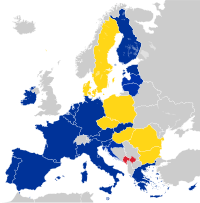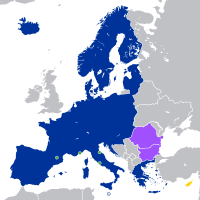European Community
| This article is part of a series on |
 |
|---|
|
|
The European Community (EC), most important of three European Communities, was originally founded on March 25, 1957 by the signing of the Treaty of Rome under the name of European Economic Community. The 'Economic' was removed from its name by the Maastricht treaty in 1992, which at the same time effectively made the European Community the first of three pillars of the European Union, called the Community (or Communities) Pillar.
European Community
European Communities is the name given collectively to the European Coal and Steel Community (ECSC), the European Economic Community (EEC), and the European Atomic Energy Community (Euratom), when in 1967, they were first merged under a single institutional framework with the Merger Treaty.
Soon after the establishment of the ECSC two more European Communities were proposed: European Defence Community and European Political Community. They were later rejected.
The EEC, established in 1958, soon became the most important of these three communities, subsequent treaties adding it further areas of competence that extended beyond the purely economic areas, while the other two communities remained extremely limited. Furthermore in 2002 the ECSC ceased to exist with the expiration of the Treaty of Paris which established it. Seen as redundant, no effort was made to retain it — its assets and liabilities were transferred to the EC, and coal and steel became subject to the EC treaty.
With the entry into force of the Maastricht Treaty in November of 1993, the European Economic Community changed its name and became the European Community. With the two other pillars, the European Community also became known as the European Union which exists today.
In October 2005 the European Energy Community was created- the first covering both the European Union and some non-member states (like the European Economic Area).
Community Pillar
The Maastricht treaty turned the European Communities as a whole into the first of three pillars of the European Union, also known as the Community Pillar or Communities Pillar. In Community Pillar policy areas decisions are made collectively by Qualified Majority Voting (QMV).
European Economic Community
The European Economic Community (EEC) was an organization established (1958) by treaty between the ECSC countries Belgium, France, Italy, Luxembourg, the Netherlands, and West Germany, known informally as the Common Market (the Six). The EEC was the most significant of the three treaty organizations that were consolidated in 1967 to form the European Community (EC; known since the ratification 1993 of the Maastricht treaty as the European Union, EU). The EEC had as its aim the eventual economic union of its member nations, ultimately leading to political union. It worked for the free movement of goods, service, labour and capital, the abolition of trusts and cartels, and the development of joint and reciprocal policies on labour, social welfare, agriculture, transport, and foreign trade.
In 1956, the United Kingdom proposed that the Common Market be incorporated into a wide European free-trade area. After the proposal was vetoed by President Charles de Gaulle and France in November 1958, the UK together with Sweden engineered the formation (1960) of the European Free Trade Association (EFTA) and was joined by other European nations that did not belong to the Common Market (the Seven). Beginning in 1973, with British, Irish, and Danish accession to the EEC, the EFTA and the EEC negotiated a series of agreements that would ensure uniformity between the two organisations in many areas of economic policy, and by 1995, all but four EFTA members had joined the European Union.
One of the first important accomplishments of the EEC was the establishment (1962) of common price levels for agricultural products. In 1968, internal tariffs (tariffs on trade between member nations) were removed on certain products.
The future of the European Communities
The signed but unratified European Constitution would merge the European Community with the other two pillars of the European Union, making the European Union the legal successor of both the European Community and the present-day European Union. It was for a time proposed that the European Constitution should repeal the Euratom treaty, in order to terminate the legal personality of Euratom at the same time as that of the European Community, but this was not included in the final version.
See also
- History of the European Union
- European Union
- European Union law
- European Energy Community
- "Common European Home"
External links
- European Union website
- Treaty establishing the European Economic Community European NAvigator
- Video : signing of the Rome treaties European NAvigator




